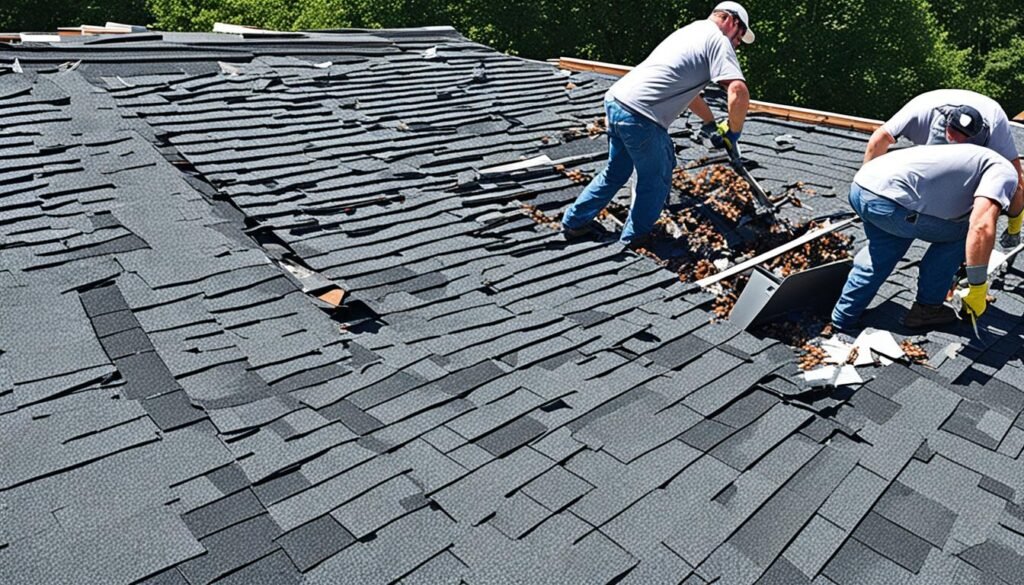Did you know that the average homeowner in the United States renovates their property every 6 to 8 years? Property renovation, including roof construction, is a significant undertaking that requires careful planning and consideration. When it comes to your roofing project, knowing what to expect can make all the difference in achieving a successful outcome.
In this article, we will provide you with an inside look at what you can expect during your roofing work. From scheduling considerations to the removal of existing materials, understanding these key factors will help you navigate the process with ease. Let’s dive in.
- Undertaking a roofing project is a significant aspect of property renovation.
- Knowing what to expect during your roofing project will help you achieve a successful outcome.
- Scheduling considerations and communication with your contractor are crucial for staying on track.
- Preparing your property for access and protecting your belongings are important steps.
- Understanding the construction process and potential disruptions will help you navigate the project smoothly.
Scheduling and Project Timeline
Proper scheduling is vital for the success of your roofing project. Various factors, such as weather conditions, backlog of work, and unforeseen circumstances, can impact the timeline and completion date of your project. Therefore, it is essential to set realistic expectations and maintain open communication with your roofing contractor.
“Effective communication and collaboration with your contractor will help ensure that your project stays on track.”
Inclement weather is one of the primary factors that can cause delays in your roofing project. Rain, snow, or high winds can make it unsafe to work on the roof, requiring the project to be postponed. To minimize the impact of weather delays, it is crucial to have a backup plan in place, allowing your contractor to adjust the construction schedule accordingly.
By actively staying in touch with your contractor and being proactive in addressing any concerns, you can maintain a smooth and efficient project timeline. Regularly check-in to receive updates on the status of your project, discuss any potential delays, and ensure that everything is on schedule. This open line of communication will help you stay informed and make any necessary adjustments.
Sample Construction Schedule
| Phase | Description | Duration |
|---|---|---|
| Preparation | Cleaning the work area, removing furniture and valuables, setting up safety measures | 1 day |
| Materials Delivery | Delivery and inspection of roofing materials and equipment | 1-2 days |
| Removing Existing Roof | Tearing off old roofing materials, inspecting the underlying structure | 1-2 days |
| Installation of New Roof | Installation of underlayment, flashing, and shingles or other roofing materials | Several days to a few weeks, depending on the size of the project |
| Finishing Touches | Cleaning the work area, inspecting the completed roof, addressing any remaining tasks | 1-2 days |
Keep in mind that the construction schedule can vary depending on the size and complexity of the project. The provided sample schedule gives a general idea of the typical timeline for a roofing project, but it is essential to consult with your roofing contractor for a more accurate and tailored schedule.
Having a well-planned and communicated project timeline will help ensure that your roofing project progresses smoothly and is completed within the expected time frame. By being aware of potential scheduling challenges and maintaining open lines of communication with your contractor, you can minimize delays and enjoy a seamless roofing experience.
Access and Preparation
Before construction begins, it’s important to make the necessary preparations to access your property. This includes ensuring clear property access for the roofing team and making arrangements for material storage if needed. Additionally, it’s crucial to protect your furniture and landscaping during the roofing process to minimize any potential damage.
Firstly, you should clear the work area of any obstacles or items that could hinder the roofing project or be at risk of damage. This includes moving outdoor furniture, potted plants, and any other items that may obstruct the roofing team’s access to the work zone. By clearing the path, you provide a safe and efficient environment for the construction process.
Secondly, you should communicate with your contractor about the need for material storage. In some cases, roofing materials may need to be stored in your yard during the project. Your contractor will discuss the best location for the storage to ensure it doesn’t interfere with your daily activities or impede access to other parts of your property. By making arrangements in advance, you can facilitate a smooth workflow for the roofing team.
Protecting Furniture and Landscaping
During the roofing process, it’s essential to take precautions to protect your furniture and landscaping from potential damage. The construction activities, such as debris removal and material installation, can pose risks to your belongings. To safeguard your property, consider the following:
- Cover or move any outdoor furniture, such as chairs, tables, and umbrellas, to a safe location away from the work area.
- If you have fragile plants or landscaping features near the construction zone, you may want to temporarily relocate them until the project is complete.
- Discuss with your contractor any specific concerns you have about protecting certain areas of your property, such as delicate flower beds or decorative structures.
By taking these steps to protect your furniture and landscaping, you can ensure that your property remains in good condition throughout the roofing project.

A roofing project can be a significant undertaking, but by preparing your property for access and taking measures to safeguard your furniture and landscaping, you can ensure a successful and worry-free construction process. The next section will delve into the removal of existing materials and the overall construction process involved in your roofing project.
Removal of Existing Materials and Construction Process
During the roofing process, the removal of existing materials is an essential step that prepares your property for the installation of new roofing materials. However, it’s important to note that this part of the project can be noisy and messy. Dust and dirt particles may fall into your attic, potentially causing inconvenience. To protect your personal items, it’s recommended to cover or remove any items that you want to safeguard.
When new materials are being installed, there might be pounding involved, which could potentially jar loose any items on your walls. While your contractor will take precautions to minimize any damage, it is advisable to remove any insecurely hung items to ensure their safety throughout the construction process.
Although rare, it’s worth mentioning that the construction process has the potential to cause cracking or falling of plaster or drywall. While your contractor will exercise caution, it’s a good idea to be aware of this possibility to minimize any surprises.
By being prepared for the noisy and dirty part of the roofing project and taking steps to protect your belongings, you can navigate the construction process with minimal stress and ensure the safety of your personal items.

| Key Points |
|---|
| Noisy and messy: The removal of existing materials can create noise and generate dust and dirt particles. |
| Protection of personal items: Cover or remove items to safeguard them from potential damage. |
| Insecurely hung items: Remove any items that might be loosely hung on walls to prevent them from falling due to pounding during the installation process. |
| Potential for cracking or falling: While rare, construction can sometimes cause cracking or falling of plaster or drywall. |
Conclusion
Undertaking a roofing project is a significant endeavor that requires the right expectations and preparation. By gaining an inside look into the scheduling considerations, access requirements, and construction process, you can ensure that your property renovation meets your expectations and delivers a high-quality roof construction.
Throughout the project, it’s important to maintain open lines of communication with your roofing contractor. If you have any questions or concerns, don’t hesitate to reach out for guidance and clarification. They are there to support you and ensure that your roofing work progresses smoothly.
With a comprehensive understanding of what to expect during your roofing project, you can approach the work with confidence and peace of mind. By taking the time to prepare your property, communicate effectively, and anticipate potential disruptions, you are well-equipped to navigate the construction process successfully.
Remember, a well-executed roofing project can enhance the aesthetic appeal and functionality of your property. So embrace the inside look into roofing work, and embark on your project with excitement, knowing that by being proactive, you are laying the foundation for a long-lasting and beautiful roof.
FAQ
What factors can impact the timeline of a roofing project?
Factors such as weather, backlog of work, and unforeseen circumstances can all impact the timeline of a roofing project.
How important is it to communicate with your roofing contractor about scheduling concerns?
It is crucial to have open communication with your roofing contractor about any scheduling concerns you may have.
What should I do to prepare for roofing work on my property?
Before construction begins, you should clear the work area, remove any furniture or items that could be damaged, and make arrangements for material storage.
What steps should I take to protect my belongings during the roofing process?
It is best to cover or remove any items that you want to protect from dust and dirt particles. Additionally, remove any insecurely hung items to prevent damage from pounding during the installation of new materials.
What should I do if I have questions or concerns during the roofing project?
Don’t hesitate to communicate with your roofing contractor if you have any questions or concerns throughout the project.
